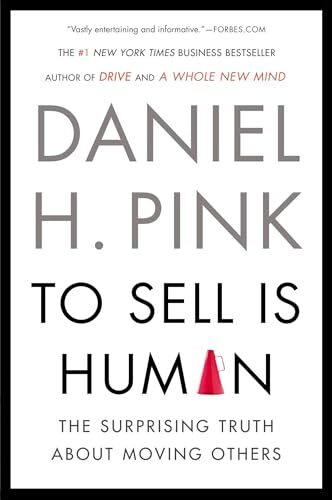
A good overview of how sales works and why today it’s more important than ever before. As with other Daniel Pink works, this book is well researched, easy to read, and contains practical advice. Some of my key takeaways were:
- In the modern world, everyone is in sales, whether or not “sales” is in your job title.
- Effective sales requires not empathy, but adopting someone else’s perspective.
- Try to include a human connection. For example, radiologists are more thorough when an x-ray or CT scan includes a photo of the original patient.
- People want a fair deal from someone they can trust. Show them it’s a fair deal by showing how it compares to the alternatives (people are not good at judging the absolute value of something, but they are good at comparisons). Gain their trust by reminding them of themselves; by finding common interests; through subtle mimicry; through light physical contact.
- Some pitch techniques: identify yourself with one word (i.e., Google is now synonymous with “search”); use rhymes (i.e., rhyming pitches are more memorable); use the Pixar pitch (i.e., “Once upon a time there was _____. Every day _____. One day _____. Because of that _____. Because of that _____. Until finally _____”); capture interest through the utility of your message (i.e., “practical advice on how to do ____”) or by peaking curiosity (i.e., “did this company finally crack the code on ____?”), but not both.
Quotes
Some of my favorite quotes:
When everyone, not just those in Tokyo and London but also those in Tianjin and Lagos, carries around her own storefront in her pocket—and is just a tap away from every other storefront on the planet—being an entrepreneur, for at least part of one’s livelihood, could become the norm rather than the exception. And a world of entrepreneurs is a world of salespeople.
Amazon, like most organizations, has lots of meetings. But at the important ones, alongside the chairs in which his executives, marketing mavens, and software jockeys take their places, Bezos includes one more chair that remains empty. It’s there to remind those assembled who’s really the most important person in the room: the customer.
Robert Cialdini, the Arizona State University scholar and one of the most important social scientists of the last generation, calls this “the contrast principle.” We often understand something better when we see it in comparison with something else than when we see it in isolation.
The most essential question you can ask is this: Compared to what? You can raise that question by framing your offering in ways that contrast with its alternatives and therefore clarify its virtues.
The purpose of a pitch isn’t necessarily to move others immediately to adopt your idea. The purpose is to offer something so compelling that it begins a conversation, brings the other person in as a participant, and eventually arrives at an outcome that appeals to both of you.
As you prepare your pitch, whichever variety you choose, clarify your purpose and strategy by making sure you can answer these three questions: After someone hears your pitch, (1) What do you want them to know? (2) What do you want them to feel? (3) What do you want them to do?If you’ve got strong answers to these three questions, the pitch will come together more easily.
Three essential rules of improvisational theater: (1) Hear offers. (2) Say “Yes and.” (3) Make your partner look good.
At every opportunity you have to move someone—from traditional sales, like convincing a prospect to buy a new computer system, to non-sales selling, like persuading your daughter to do her homework—be sure you can answer the two questions at the core of genuine service. (1) If the person you’re selling to agrees to buy, will his or her life improve? (2) When your interaction is over, will the world be a better place than when you began? If the answer to either of these questions is no, you’re doing something wrong.
